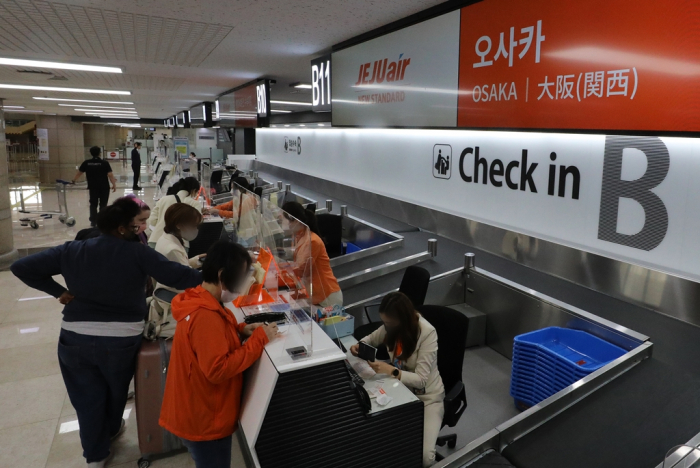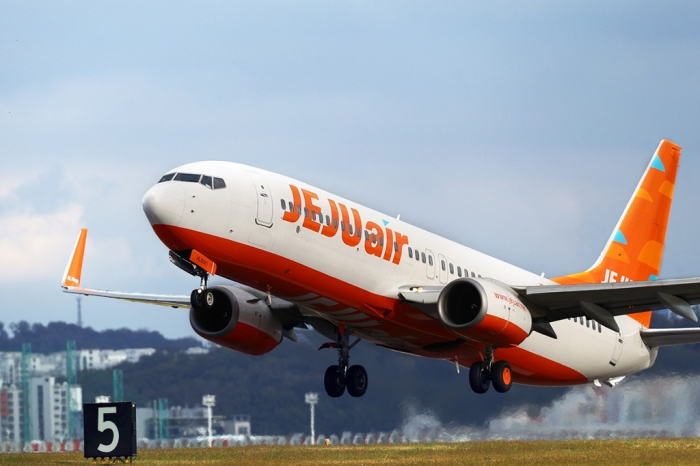Airlines
Jeju Air rules Korea-Japan routes to beat legacy carriers
Strong recovery in short-haul flights is expected to help the LCC turn around; appreciation of won, drop in oil prices are also favorable
By Dec 09, 2022 (Gmt+09:00)
2
Min read
Most Read
LG Chem to sell water filter business to Glenwood PE for $692 million


Kyobo Life poised to buy Japan’s SBI Group-owned savings bank


KT&G eyes overseas M&A after rejecting activist fund's offer


StockX in merger talks with Naver’s online reseller Kream


Mirae Asset to be named Korea Post’s core real estate fund operator



Jeju Air Co., South Korea’s largest budget airline, is dominating flights to Japan to beat full-service carriers (FSCs) in the country such as Korean Air Lines Co. on the routes, raising hopes for a quick turnaround after losses for the last 14 straight quarters.
Jeju Air has carried 344,181 passengers between the two countries since Oct. 11 when Japan allowed South Koreans to visit there without visas, according to data from the government on Friday.
Korean Air and its smaller FSC rival Asiana Airlines Inc. served 183,068 customers and 146,098 passengers on the routes during the period, respectively. Jeju Air also beat other low-cost carriers. Jin Air Co., the LCC unit of Korean Air, carried 198,429 customers.
The number of Jeju Air’s flights for the South Korea-Japan routes more than doubled those of Korean Air and Asiana. As of the first week of December, Jeju Air operated 178 flights for the routes a week, compared with Korean Air’s 88 flights and Asiana’s 62 flights.
The leading domestic LCC ramped up flights earlier than other airlines with expectations of rising demand when authorities eased restrictions against COVID-19, helping dominate the routes.
“We took a strategically bold step to increase flights as we predicted the market will recover from short-haul flight services,” said a Jeju Air official.
Even before the pandemic broke out, Jeju Air was the top carrier for South Korea-Japan routes with a market share of 17.1%. It operated some 20 regular flights for nine destinations in Japan, generating more than 20% of its sales from those flights.
It has now resumed 11 flights for six cities such as Tokyo, Osaka and Fukuoka, raising its market share to 26.2% in the last two months.
RISING TURNAROUND HOPES
Short-haul flights often generate more profits than long-distance routes due to lower fuel costs. Jeju Air is expected to turn to the black from the current quarter thanks to a strong recovery in the South Korea-Japan routes, analysts said.
The airline was forecast to report an operating profit of 800 million won ($613,968) in the October-December period and 470 billion won next year, according to financial data provider FnGuide Inc. It has been in the red since the second quarter of 2019.
Jeju Air has the largest fleet among local LCCs with 38 aircraft including one freighter. All of them are one model – B737-800 – helping it spend less for operations than its competitors.

The carrier is scheduled to introduce new aircraft – B737-8 – in stages from next year, which is expected to help cut costs due to its high compatibility with Jeju Air’s existing airplanes. In addition, Boeing’s B737-8 can fly some 1,000 kilometers more than the B737-800, which will allow the LCC to serve longer-haul routes such as ones to Indonesia. Its fuel economy is also better, cutting operating costs per seat by 12%.
A rebound in the South Korean won currency and falling oil prices are expected to help the carrier turn around.
The won has appreciated 11% against the dollar since Oct. 25 when the local unit fell to its weakest level since the 2008-09 global financial crisis, cutting foreign currency debt service costs and fuel purchase expenses.
Write to Seo-Woo Jang at suwu@hankyung.com
Jongwoo Cheon edited this article.
More to Read
-
 Foreign exchangeKorea won near 5-mth high as Powell signals slower hikes
Foreign exchangeKorea won near 5-mth high as Powell signals slower hikesDec 01, 2022 (Gmt+09:00)
2 Min read -
 AirlinesKorea airlines grounded by oil, currency, interest rates
AirlinesKorea airlines grounded by oil, currency, interest ratesJun 17, 2022 (Gmt+09:00)
2 Min read
Comment 0
LOG IN


